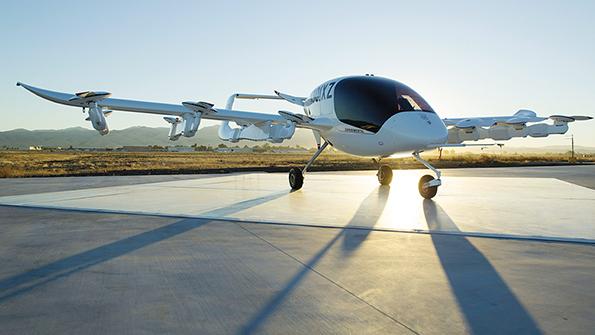
SINGAPORE—The joint venture behind a secretive self-flying electric air taxi project debuting at this year’s Singapore Airshow is disclosing new details about the vehicle, which has been approved by the New Zealand government to conduct passenger trials in Canterbury, a city in the nation’s South Island.
Developed by Wisk, a joint venture startup between Boeing and Kitty Hawk, the electric vertical takeoff and landing (eVTOL) Cora is a two-seat autonomous vehicle powered by 12 boom-mounted independent lifting propellers for vertical flight. The booms are distributed along a 36-ft.-span wing that supports forward flight along with an aft-mounted pusher propeller. All propellers are powered by a pack of lithium-ion batteries.
“It also has a parachute recovery system,” Wisk CEO Gary Gysin said. “It is one of several safety aspects of the design. Whenever we fly along a route we always have multiple emergency landing spots and, being able to land anywhere, you have space everywhere in an emergency. And as a last resort we also have the emergency parachute—there is no single design point of failure.”
Differing from most other eVTOLs in development, which are designed to be piloted, at least initially, the Cora is designed to be autonomous from the start. “We are going straight to self-flying with two seats, so it is not optionally piloted,” Gysin said. Even though the bulk of other concepts targeting the urban air mobility (UAM) sector are larger vehicles with space for four to five seats, he believes the Cora will fill a large market niche.
“The sweet spot is anywhere from 30-to-60-mi. range with reserves and 100 kt.-plus in speed. But based on the analysis we’ve done from a commuter perspective, when we are attacking that kind of market most of it says you are looking at 1.6 to 1.7 riders per vehicle. Clearly that data comes from the auto market, but we think that extrapolates into this market,” he said. “Having said that, we also think there’s going to be stratification into various two- and four-seat options, plus larger regional options, and we think there’s going to be variability just like there is in today’s commercial aviation market.”
Prior to the passenger-carrying trials, the Cora will be certified by the New Zealand Civil Aviation Authority, which has been working with Wisk and its predecessor companies for several years.
“We have a certification basis to fly already and we are finishing that up and hope to get that soon,” Gysin said. “We have made a conscious decision not to give certain dates. We will fly when it’s safe and we are certified.”
Wisk is a partner in the New Zealand government’s Airspace Integration Trials program, which was established in October 2019 to accelerate the testing and fielding of advanced unmanned aircraft. New Zealand recently set a goal to become carbon neutral by 2050.
Wisk believes the faith of Boeing and the New Zealand government in the project is founded in the company’s relatively long development heritage, which stretches back for a decade. Backed by Google co-founder Larry Page, the company originally was founded as Zee Aero in 2010 and flew its initial concept vehicle the following year. Zee Aero, which in 2017 was absorbed by Kitty Hawk—another Page-backed company—went through six different prototype iterations “before landing on the current design,” Gysin said. “There were a few piloted versions until this final variant.” Between sites in California and New Zealand, multiple examples of the current vehicle have collectively flown more than 1,000 test sorties to date.

Comments